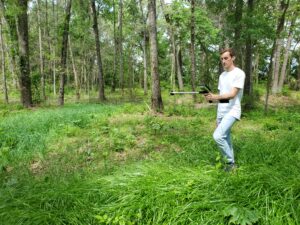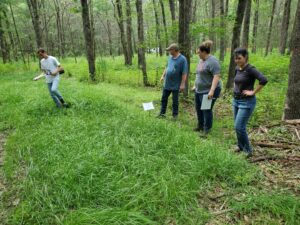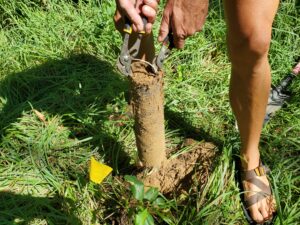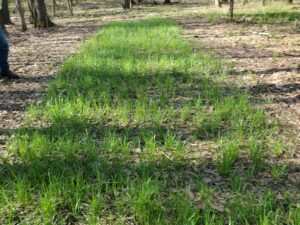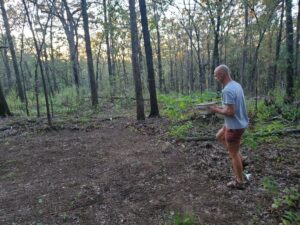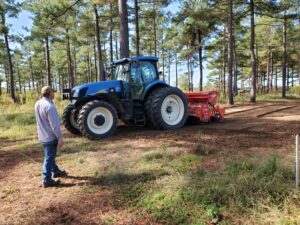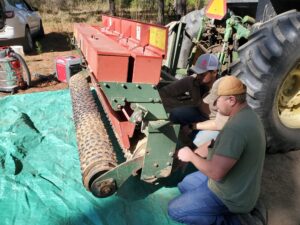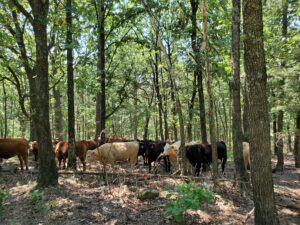Final report for LS19-316
Project Information
There has been an increased interest in silvopasture in Arkansas due to incentives related to diversified production resulting in short term profits from beef production and long term profits from timber production, as well as, creating wildlife habitat and additional hunting land. Many small beef producers have attempted to adopt silvopasture, but have failed to establish grazing forage, discouraging further pursuit.
In Arkansas, there are typically two types of silvopastures, one in established loblolly pine (Pinus taeda) plantations and the second, in natural forests that have regenerated from a previous timber harvest or long-term fallow pasture. This project aims at evaluating forage species and establishment method for both silvopasture types.
In established plantations, this project will test eight different high quality perennial and annual grasses including novel-endophyte tall fescue (Lolium arundinaceum), Italian ryegrass (Lolium multiflorum), annual ryegrass (Lolium multiflorum), and orchardgrass (Dactylis glomerata); and also annual and perennial legumes including crimson clover (Trifolium incarnatum), arrowleaf clover (Trifolium vesiculosum), white clover (Trifolium repens), and alfalfa (Medicago sativa) in single 40-foot alleys. Forages will be measured for seasonal biomass distribution persistence, yield, and nutritive parameters including crude protein, neutral detergent fiber, in-vitro true digestibility, and neutral detergent fiber digestibility.
The second project aims to test the influence of decreasing levels of timber basal area in un-managed forests on growth and persistence of orchardgrass and crimson clover and arrowleaf and novel endophyte tall fescue. The main research will be completed at USDA-ARS Dale Bumpers Small Farms Research Center in Booneville, AR, which has both loblolly pine plantation and un-managed forests with mixes of hard and soft woods. Demonstration plots will be created on three cooperator farms in Arkansas to show variety in silvopasture types and create diverse environments for testing forage establishment. The success or failures on the on-farm demonstrations will allow researchers the opportunity to understand common forage establishment issues on farm, and will help to strengthen the researchers’ applied knowledge, as well as the supporting educational materials.
Three field days will be held, one in every year, with each focusing on a different topic. All field days will involve farmer cooperation and local foresters. A step-by-step video database will be created to share knowledge from farmer cooperators, scientists, and forester consultants. The videos will cover six topics: an overview of silvopasture; timber management in existing plantations and natural forest; planning and starting silvopasture with new plantings; forage establishment, production, distribution; matching cattle requirements; and an economic model for silvopastures in Arkansas.
- Determine the suitability (seasonal forage distribution, production, quality, and persistence) of annual and perennial legumes and cool season grasses in single row 40-foot alleys in Arkansas loblolly pine silvopastures;
- Determine the suitability (seasonal forage distribution, production, quality and persistence) of orchardgrass/crimson clover mix and arrowleaf/novel endophyte tall fescue species in naturally regenerated hard and soft wood forests thinned to three different basal areas, a control no thinning (or minor thinning to approximately 60 sq. ft.), 40 sq. ft., and 20 sq. ft. per acre;
- Develop an extensive video library that outlines and describes common methods for silvopasture establishment and management around the state;
- Create a working group of farmers, NRCS, ARS, and University of Arkansas experts to support ongoing silvopasture management with current and perspective farmers involved in the project;
- Evaluate the most economically viable system based considering both timber and forage growth, and estimates of cattle performance.
Cooperators
- - Producer (Educator)
- (Educator)
Research
We received funding in July 2019 and implemented the first research study in fall of 2019. Onsite research takes place at the USDA-ARS station in Booneville AR. There are two experiments: 1) annual and perennial grass and legume establishments in pine tree alleys; and 2) perennial cool-season forage grass establishment in a hardwood forest thinned at different levels.
Pine plantation experiment:
- Plots in the pine plantation were started with preparation for planting in August 2019, with planting occurring on October 3, 2019. Seedling counts were conducted on October 28. Further plot maintenance, including fertilization with P and K, occurred in fall, and with N fertilization in spring. Plot harvests occurred on April 3, May 21, July 10, with one more additional harvest for the perennials planned for late September. Data collected: yield, subsamples for later determination of botanical composition, and subsamples for forage quality. Botanical composition and forage quality will be determined in the lab over winter.
- Plots were last harvested end of September. In that instance, we only harvested the perennial forage plots as the annual forages already senesced in early summer. Biomass was collected at the same dates for all forages throughout the growing season, 3 times between March and June, and 1 time in September for the perennials.
- Annual forage plots were replanted in early October of 2020. Prior to planting, plots were terminated with glyphosate, disked lightly, and planted with the same seeding rates as the year prior. Forages replanted included annual ryegrass, Italian ryegrass, crimson clover, and arrowleaf clover
- Fertilizer (P and K ) was applied after planting to those plots, while N fertilizer was applied in March of 2021
- Plots were harvested as the year before in April, end of May, and mid-July to keep the same harvesting schedule from the year prior
- In fall of 2021, we replanted all annual experimental plots:
- tillage was performed with a rotor tiller at an approximate depth of 5 inches
- in the fall of 2021, the soil in the experimental area was very dry so tillage proved challenging
- planting of annual forages was accomplished with a 'Brillion' seeder
- During the growing season of 2022, we followed the same procedures as in the previous two years
- fertilizer (P and K) applied after planting to all plots
- N applied in March of 2022
- During Year 3 of the experiment, we again harvested all plots mid-April, end of May, and mid-July; and the last harvest was completed in October of 2022 (perennial plots only)
Hardwood forest experiment:
- On June 18, 2019 we met with forester Tim White to discussion TSI on the hardwood stand. A plan was developed for the thinning. On July 2, 2019 Dirk, Robert, and Christine marked the 9 plots in the hardwoods. On October 28 and 29th 2019, Tim marked the trees necessary for removal to meet the desired basal areas. On May 21, 2020, Tim’s crew competed the herbicide injection on the trees set for removal. Soil samples were taken by Christine Nieman, Robert Rhein (research associate), Dirk, and soil scientist collaborator, Mary Savin from the University from Arkansas, on June 30th and July 7th, these soil samples will be used for measures of soil health in the converted forest. This fall, small undesirable trees will be removed with a mulcher attached to skid steer, in order to make room for planting equipment.
- In early September of 2020, preparation work began in the hardwood area. A skid steer with a mulcher attachment was used to clear brush and small trees, and prepare the areas for future forage plantings. At times, work had to be paused because of wet conditions and equipment breakdowns, but as of late October most of the area was ready to plant. This is somewhat later than we planned, but we decided to still plant this fall, albeit later than anticipated.
- Research plots were established on November 19, 2020. This was later than planned, but still within the anticipated time frame. Forages planted were orchardgrass and novel endophyte tall fescue, as these are options that can be easily established for both research and demonstration purposes.
- Forages were planted both at 20 lbs/acre. Plots were limed with 1500 lbs / acre and fertilized with P and K on December 8th, 2020.
- These forages were planted on hill sides and bottom sites based on the topography of the hardwood area. In each experimental unit, two hill and two bottom sites were planted to account for the different hydrological conditions of the research area
- Major progress was made on the expansion of soil data collection: we built 60 root core that will be installed early April in all experimental units of the hardwood area. Each core measure 9 x 30 cm, is made from wire mash, and wrapped in window screen. Soil with the approximately same volume will be removed from the ground, sieved to remove roots, and filled back into these cores which will then be inserted into the ground. We will monitor root growth in our forage research plots as well as in adjacent woody areas. This method has been referenced and will captures data on growth and development of finer roots that can penetrate the 1.5 x 3 mm window screen.
- Soil samples obtained in summer of 2020 have been ground in February of 2021 for further analyses.
- In January of 2021, we added a graduate student, Matt Janorschke, to the project. Matt will focus on the soil-scientific aspect of the project. His research project will focus on analyzing baseline samples obtained in summer of 2020, and collecting data in root growth from root cores to be installed in April of 2021.
- Biomass from forage plots were harvested twice in 2021 (June and October) and once again in 2022 (June)
Soil-specific experiments:
- We identified high and low-laying areas to be sampled
- high approximately 142-145 m above sea level
- low approximately 139 - 141 m above sea level
- Within each thinning treatment, we identified 2 high and 2 low locations
- Soil sampling was conducted in 2020 as part of baseline data collection
- In April of 2021, we installed root cores to measure root growth over the period of 12-14 months
- out of 72 locations (plots) with forages planted (tall fescue and orchardgrass) we selected 48 suitable one
- some of the low-laying areas were temporarily inundated, so we did not install root cores there
- we also installed
- In June of 2022, root cores were removed
- General soil sampling was conducted in June 2021, November 2021, and June of 2022
Light measurements
- Photosynthetically active radiation (PAR) measurements were conducted to evaluate irradiance in both the pine tree and hard wood areas
- measurements were taken in June of 2021 and February of 2022 in the hard wood area, and 4 times over the course of the experiment in the pine tree area
Research/Demonstration on cooperator farm (Rennie Reynolds)
- Demonstration plots were established on October 15th, 2020 on Rennie Reynolds cooperator farm
- In mid-September, we selected multiple sites in a forested area that was treated with the "hack & squirt" methodology earlier in the year as part of our grant
- A total of 12 sites over a 500 yard distance of forest were selected, each consisting a single planting of a forage species or side-by-side planting; forages species were novel-endophyte tall fescue, orchardgrass, or annual ryegrass
- Those species were selected based on the research done in the pine trees and also based on the hardwood research site at USDA-ARS Booneville, AR
- Each plot was 10 by 20 feet in size, and seeds were applied with a hand-held broadcast spreader; seeding rates used were 20 lbs/acre for each species
- Established plots were visited on November 24th 2020 to check on seedling emergence and perform a basic seedling count/frequency. All seed emerged relatively well.
- Demonstration plots were revisited several times over the project period (spring, summer, and fall of 2021 and spring 2022)
Additional demonstration plots
- In fall of 2021, we broadcast-seeded 8 demonstration plots with white clover and tall fescue and various low and high locations
- this was conducted to see of minimal soil disturbance (dragging with a harrow) may result in a measurable establishment success
- As of November 2020, we are in the process of analyzing data collected during 2020 from the plot research in the pine tree alleys
- this part of the project refers to 8 species of annual and perennial forages planted in existing pine stands
- Data includes biomass accumulation in both annual and perennial forage species, species composition, and seedling emergence (total biomass in 2020, pine alleys):
These are results (annual DM production) from 2020:
| Species | tons/acre |
| Alfalfa | 1.46 |
| Orchardgrass | 2.01 |
| Tall Fescue | 2.47 |
| White Clover | 1.79 |
| Annual Ryegrass | 1.94 |
| Arrowleaf | 1.56 |
| Crimson | 1.52 |
| Italian Ryegrass | 1.89 |
Here are some selected data we have generated so far from the Pine Alley experiment:
DM Production for April 2021
| Alfalfa | 757.17 |
| Annual Ryegrass | 1195.05 |
| Arrowleaf | 421.40 |
| Crimson | 545.40 |
| Italian Ryegrass | 775.89 |
| Orchardgrass | 830.34 |
| Tall Fescue | 1134.64 |
| White Clover | 1091.38 |
DM Production May 2021:
| Alfalfa | 1518.16 |
| Annual Ryegrass | 1513.29 |
| Arrowleaf | 1267.55 |
| Crimson | 1417.13 |
| Italian Ryegrass | 1731.54 |
| Orchardgrass | 2139.83 |
| Tall Fescue | 2053.36 |
| White Clover | 1351.13 |
DM Production for July, 2021:
| Alfalfa | 216.75 |
| Annual Ryegrass | 401.67 |
| Arrowleaf | 213.11 |
| Crimson | 269.51 |
| Italian Ryegrass | 263.92 |
| Orchardgrass | 275.91 |
| Tall Fescue | 249.25 |
| White Clover | 198.76 |
DM Production for October, 2021:
| Alfalfa | 955.91 |
| Orchardgrass | 501.40 |
| Tall Fescue | 581.34 |
| White Clover | 272.13 |
For biomass in our hardwood area during June of 2021, we found the following results:
| Basal area sqf/acre | Biomass | St. Dev | SE |
| 30 | 67.66 | 29.68 | 5.71 |
| 50 | 65.01 | 27.87 | 5.69 |
| 70 | 44.29 | 19.11 | 3.82 |
These data show that in general, biomass DM production can be higher in hardwood areas that are thinned to a level of about 1/4 of the original basal tree area (sqf/acre).
Light measurements:
| Basal Area | PAR | St. Dev | SE |
| 30 | 1084 | 335 | 55 |
| 50 | 1022 | 370 | 52 |
| 70 | 1109 | 399 | 182 |
These are the results from March 1, 2022. There's little difference in PAR obviously across the thinning treatments. This was somewhat unexpected, but it is possible that the remaining trees expanded their canopies and thus light influx was relatively similar across the experimental site.
Pictures
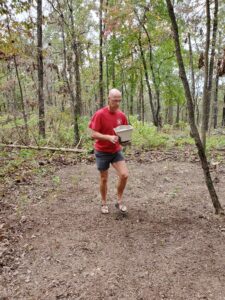
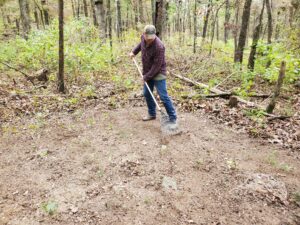
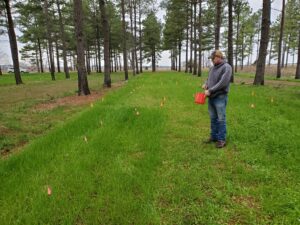
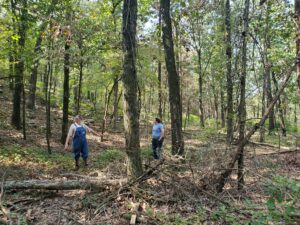
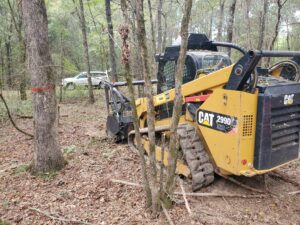
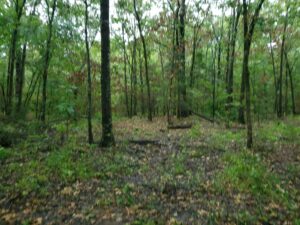
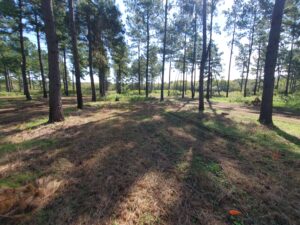

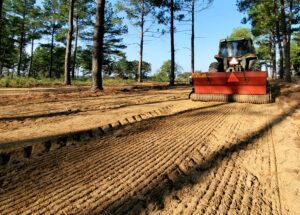



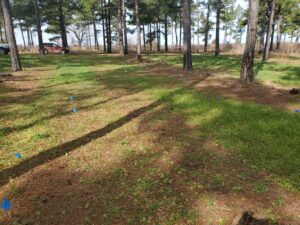



Education
We have worked most closely with a cooperating producer (Rennie Reynolds) to develop educational materials for producers and landowners. This will include a handbook on how to get started with silvopastoral systems including a video library describing forestland transition, thinning, and planting of forages. Due to the covid pandemic, we were not able to engage in substantial in-person on-farm outreach , but were able to co-host a field day in fall of 2019 in cooperation with the University of Missouri - Center for Agroforestry.
Although we have not finished the silvopasture handbook and videos yet, we will continue editing both as additional projects materialized over the past 12 months that will directly contribute to those items. To finalize both, we would like to include full results for which data analysis is underway.
Educational & Outreach Activities
Participation summary:
Outreach
- A field day at Heifer Ranch was scheduled for fall 2019. Due to extremely excessive rainfall and flooding in spring of 2019, we were unable to plant annual species at Heifer Ranch and could not hold a field day. The plan was to move that field day to 2020, but due to COVID-19 we were unable to host a field day either at Heifer Ranch or USDA-ARS in Booneville. We hope to host field days at both locations in year 2, however, if the COVID-19 situation still does allow for field days, we will prepare a virtual field day. However, we were able to co-host a field day with the University of Missouri Center for Agroforestry in November 2019 and took advantage of the opportunity to speak about our SARE project at SSAWG in January 2020.
Video Series
- On Thursday July 9th, 2020, filming started at with Rennie and Tim at Rennie’s farm. This part of the video series will focus on TSI, how its done, how to choose trees, what is basal area, etc.. During this visit footage also included interviews with Rennie and his motivation for utilizing silvopasture on his personal farm. Video footage will continue to be taken, with the final editing occurring in year 3. Additional footage has been recorded during planting activities in October and November 2020
- We have not concluded the video series yet but will complete it during the next 12 months. Additional footage will be obtained with help from cooperating staff and faculty.
Handbook
- We started drafting and editing a handbook based on our research and experience establishing forages in both pine tree alleys and hardwood areas
- The handbook will encompass all aspects of site preparation and forage establishment
- The video library will be based on the outline of the handbook
- We regret that we have not finished the handbook yet but will continue editing it and anticipate finishing it in 2023
Work with cooperators:
Rennie Reynolds place, Subiaco, AR
- The project PIs attended a Field Day hosted by Rennie Reynold’s on November 9th, 2019 This field day was co-hosted by University of Missouri Center for Agroforestry, University of Arkansas Extension, Green Cover Seeds, and USDA-ARS Dale Bumpers Small Farms Research Center. We toured Rennie’s farm and described the newly awarded SARE grant with participants (approximately 20 in attendance)
- CO-PI Christine Nieman worked with Rennie Reynold’s on a presentation of his experience developing silvopasture on his farm for Southern SAWG. This presentation was given by Christine Nieman, in place of Rennie Reynolds, on Saturday January 25th, 2020 in Little Rock, AR (approximately 40 in attendance).
- On Thursday July 9th, 2020 Dirk Philipp and Christine Nieman visited with Rennie and forester Tim White on Rennie’s farm. Scientists, Rennie, and Tim chose areas for the research site. Tim began the timber stand improvement (TSI) process, which continued over the following week. Dirk began filming for the informational videos focused on the TSI process and also interviewed Rennie for his part in the instructional video.
- In fall of 2020 and 2021, we established various demonstration plots on a cooperator's property. These plots were broadcast seeded with tall fescue, orchardgrass, and crimson clover
- We returned on a regular basis to this property to monitor these plots, assess seedling emergence, and collect biomass to estimate DM production
Young Scholar Internship
- We were able to receive a SARE Young Scholar grant and support a high school intern for our soil science component during the summer for 2021
Learning Outcomes
Project Outcomes
Project outcome are as follows. I'll use a bullet-point list to include as much information as possible:
- We made important steps forward in Arkansas to put agroforestry and silvopastoralism on the map
- The project outputs may appear not much by the numbers, but farmers and landowners in the state are well aware of our activities and inquire about it; the number of interested individuals is very hard to estimate however
- We reach a very diverse audience with our activities, in-state and out-of-state
- abstracts were delivered at national meetings, thereby increasing exposure of our project
- on-station (USDA-ARS) field days were used to highlight the project and promote our findings and practices
- farmers/landowners inquired about our work and followed the newsletter articles we wrote on agroforestry issues
- This project lead to new projects that build upon our findings and direction of work:
- a new SARE project "Soil for Water" which falls into the category of sustainable grazing operations (cooperating)
- a new USDA grant that seeks to establish native grasses organically
- this will help in developing strategies for establishment that can be used in sensitive riparian/wooded settings
- a new collaboration with Quail Forever (maintained by the Arkansas Game Commission) with the goal to establish native grasses in pine tree plantations; this will take our work further by adding an ecosystem/wildlife component to silvopastoral management and our long-term work
- Economic Sustainability
- we did not assess economics with our project, but there are several issues to consider:
- farmers may not see an immediate benefit from planting forages into pine or hardwood areas
- returns may be measured in tangible and intangible items, such as improvement of livestock wellbeing, wildlife habitat improvement, and changes in microclimate that have certain long-term effects on plant growth, DM production, and ultimately animal gains
- we did not assess economics with our project, but there are several issues to consider:
- Environmental Sustainability
- we showed that we can reliable establish forages in hardwood and pine tree plantations, although questions remain regarding long-term DM production and persistence
- this will allow increased flexibility for grazing during times of the year when livestock seeks shade
- With increased summer rain variability, silvopastoral areas can mitigate the effects of high day time temperatures, decrease evaporation rates, and help persist cool-season forages such as legumes
- Social Sustainability
- Those farmers we worked with and asked us for input over the years are enthusiastic about the direction they are going with their operations
- Our project showcased that integrating natural resources on farms may also make rural spaces more attractive for the landowners, improve aesthetics, and ultimately keep landowners engaged and committed
- We also think that beginning farmers are perhaps more open to this form of livestock operation than perhaps those who have operated in the same ways for decades
Other general observations:
- Educational outputs and outcomes were hampered by the pandemic
- We are also behind with editing the handbook and the video series
- we have all the data to finish the handbook, but still have to get some video footage to come up with a good product
- We still need to get some key footage and will obtain that from the project or in other settings
I think the overall project length possible should be 4-5 years. Also, it would help if SARE could support tuition payments in addition to graduate student stipends.

